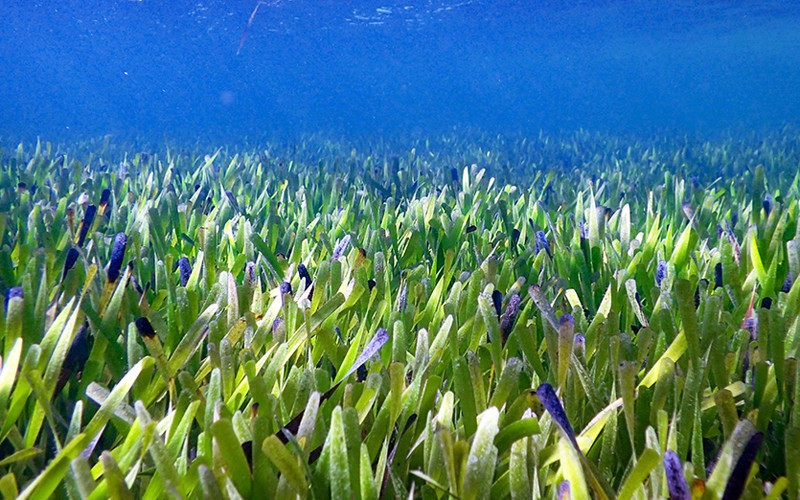
Ha Sy Dong, deputy chair of the Quang Tri People’s Committee, said in addition to selling carbon credits from natural forests, the province can also exploit carbon credits from the 26,000 hectares of planted forests with FSC (Forest Stewardship Council) certificate and VFCS/PEFC (Vietnam Forest Certification Scheme/ Programme for the Endorsement of Forest Certification)
The provincial authorities have been assigned the Department of Natural Resources and the Environment to implement the task of researching and assessing the current situation and carbon storage capacity of the seaweed beds in Quang Tri’s sea. This is a great potential for Quang Tri to exploit and sell carbon credits in the future.
Scientists all affirm that seaweed plays a very important role in life, participating in the nutrient cycle in seas and oceans. In terms of ecosystem and environment alone, seaweed has value of $3.8 trillion, or $212,000 per hectare of seaweed per annum.
In addition, seaweed ecosystem also has much importance in mitigating climate change. It can store 19.9 billion tons of organic carbon, or 2-3 times higher than the storage capacity of forest plants on the same units of area.
In 2022, the prices of carbon credits from seaweed were between $11 and $35, while the figure is predicted to increase to $60 by 2050, or $8-10 higher than the prices of normal carbon credits.
Dong said developing seaweed will create a new source of income by participating in programs and projects on exchanging and clearing carbon credits in the international market. This will help Quang Tri fulfill commitments in emission reduction and adaptation to climate change, and also help promote sustainable economic growth.
Citing recent research about Vietnam’s seaweed beds, Dong said there are two species of seaweed in Quang Tri, including Zostera japonica and Ruppia maritima. The seaweed has developed in an area of 400 hectares, mostly found at Cua Tung and Cua Viet sea.
At Cua Tung, on both sides of Ben Hai River, seaweed grows strongly. On the northern bank of Ben Hai River in Vinh Giang Commune of Vinh Linh), the seagrass creates a bed, about 800-900 meters long and 30 meters wide from the bank to the riverbed. On the southern bank of Ben Hai, in Tung Luat Village of Trung Hai Commune (Gio Linh), seagrass grows densely, forming a bed with 1,200-1,500 meters in length and 20-35 meters in width.
In Cua Viet area, the south bank in Ha Tay Village in Trieu An Commune, seaweed has developed into a bed 1.5-2 kilometers long and 100 meters wide, with coverage of 60-100 percent. Similarly, there is a large seagrass bed in the northern bank.
However, a project on surveying and assessing the current situation and changes in pollution in the central coastal areas implemented in 2016 found that after Formosa’s scandal (the marine life disaster and water pollution crisis affecting Ha Tinh, Quang Binh, Quang Tri and Thua Thien - Hue provinces in central Vietnam), the seagrass population in the coastal areas of Quang Tri in particular and the central region in general seriously declined.
In Cua Tung area, the seagrass area has reduced to 1.5 hectares with coverage of 50 percent. In Cua Viet area, there is only small area of seagrass which can be found in some aquaculture ponds. The seagrass has sharply declined in both species and area.
Meanwhile, a report on island resources profile of Quang Tri province conducted by the Department of Natural Resources and Environment in 2021 showed that in Con Co island area, there was only one species - Halophila ovalis, scattered on muddy sand around the island with very small coverage and low density. There has been no data about the area of seagrass there.
Dong stressed that together with coral reefs and mangrove forests, seaweed is one of three important coastal ecosystems which can offer high ecological service and environmental value.
The marine environment bears influences from waves, wind, and currents. The presence of leaves, upright stems, and root systems of seagrass can help reduce the impact of waves, creating favorable conditions for marine organisms to reside, hide, and escape predators.
Seagrass leaves act as water filters, making the water purer. In addition, the root and underground stem systems of seagrass hold and stabilize the bottom, preventing erosion in coastal areas.
International experts estimate that one hectare of seaweed can provide services with value of $19,000 each year.
Tam An